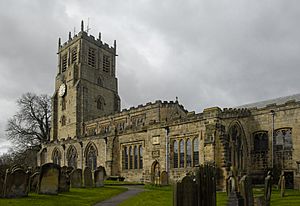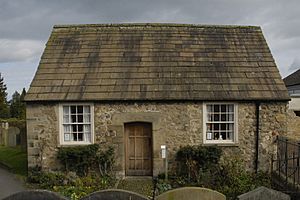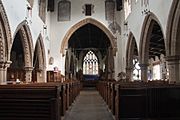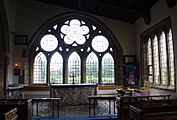Church of St Gregory, Bedale facts for kids
Quick facts for kids Church of St Gregory, Bedale |
|
|---|---|
| St Gregory's Church | |

The Church of St Gregory in Bedale
|
|
| Lua error in Module:Location_map at line 420: attempt to index field 'wikibase' (a nil value). | |
| OS grid reference | SE265884 |
| Location | Bedale, North Yorkshire |
| Country | England |
| Denomination | Church of England |
| Weekly attendance | 80–100 (average) |
| History | |
| Status | Parish church |
| Dedication | Pope Gregory I |
| Architecture | |
| Functional status | Active |
| Architectural type | Early English Decorated Perpendicular |
| Specifications | |
| Length | 120 feet (37 m) (west to east) |
| Width | 61 feet (19 m) (north to south) |
| Spire height | 98 feet (30 m) |
| Administration | |
| Parish | Bedale |
| Deanery | Wensley |
| Archdeaconry | Richmond and Craven |
| Episcopal area | Ripon |
| Diocese | Leeds |
The Church of St Gregory, Bedale is a historic church in Bedale, North Yorkshire, England. It serves as the main church for the area. A stone church was first mentioned here in the Domesday Book way back in 1086. The church you see today was mostly built starting in the late 1100s. It has been updated and restored many times over the last 800 years.
This amazing building is a grade I listed site, meaning it's very important. It has cool features like an old picture of a left-handed St George fighting a dragon. The church's tower, located on the west side, was even built with a special gate called a portcullis to help defend the town!
You can find the church at the 'Top of the Town', which is at the north end of the main street. Its churchyard has old yew trees and slopes down towards Bedale Beck. This church is so special that it's even featured in the book England's Thousand Best Churches by Simon Jenkins.
Contents
History of St Gregory's Church
Early Beginnings and Anglo-Saxon Roots
The Domesday Book from 1086 tells us that a church already stood on this spot. This means the church likely survived the difficult period known as the Harrying of the North. Experts believe parts of an even older Anglo-Saxon church, built around 850 AD, are still part of the current building.
Inside the church's crypt, old stones from before the Norman Conquest were found. These stones have carvings of serpents biting their tails. One even shows a serpent with a human head, telling the story of "The Temptation." The crypt is under the main altar area and still holds two of these ancient stones. It might have been a storage room for church items before becoming a burial place.
Building Through the Centuries
While the current church mostly dates from the 1200s, many parts were added or changed in the 1300s, 1400s, and 1800s. For example, the main part of the church (the nave) and the north side aisle are from the 1100s or 1200s. The south aisle and a small chapel on the south side were built around 1290.
Because it was built over many years, the church shows three different styles of architecture: Decorated, Early English, and Perpendicular. The church is dedicated to Saint Gregory, but no one knows the exact date it was named after him. It was definitely known as St Gregory's Church by 1547.
The Defensive Tower
The church's tower is about 98-foot (30 m) tall. It's quite unusual for this part of Northern England because it was built like a fortress! Around the 1330s, it was designed to protect the people of Bedale from attackers. A heavy gate called a portcullis was installed at the bottom of the tower. You can still see the grooves where it used to slide down. It was forgotten for a long time until it crashed down in the 1800s because of rust.
The middle floor of the tower has a fireplace and other features that suggest people lived there. It's thought that this tower was once part of Bedale Castle, which was right next to the church. The very top part of the tower has a Perpendicular style with eight pointy decorations called pinnacles. Other churches nearby, like those in Melsonby and Thornton Watlass, also have similar fortified towers. The clock on the tower was given to the church by the Beresford-Peirse family in 1873.
Hidden Wall Paintings
During restoration work in the 1920s, several old wall paintings were discovered. These include "The Creed" and "The Lord's Prayer" above the main part of the church. There's also a painting of St George fighting a dragon in St George's Chapel. These paintings are thought to be over 500 years old! The St George painting is quite special because it shows him fighting the dragon with his left hand. It's believed these paintings, which show the church's old Catholic history, were covered up with white paint during The Reformation.
The Jervaulx Bell
The church has one of the oldest bells in England that can still be rung. It weighs about 26 long cwt (2,900 lb or 1,300 kg) and was put in place in 1360. This bell is known as The Jervaulx Bell because it came from Jervaulx Abbey in the mid-1300s. The other eight bells in the bell tower were added later, between the 1600s and 1800s.
Windows and Light
The beautiful east window in the Lady Chapel (the south aisle) is also thought to have come from Jervaulx Abbey after it closed down. The famous art historian Pevsner noted that most other windows in the church are from the Victorian era. A high row of windows, called the Clerestory, was added around 1400. These four windows on each side let a lot of light into the church.
St Gregory's is the main church for the area of Bedale, Leeming, and Thornton Watlass. This group of churches was formed in 2007 when there weren't enough clergy. In 2016, the church roof was replaced with stainless steel after the original lead was stolen. This special change was allowed by Historic England, and a grant helped pay for it. Simon Jenkins, in his book, called St Gregory's "...a strong church in every sense [with] a fine crypt.... and magnificent headstones."
Effigies and Monuments
Inside the church, you can find several old tombs and statues, called effigies. The tomb of Bryan FitzAlan and his first wife used to be on the south side of the church. Their two effigies now rest at the north-western end. There's also an effigy of Brian de Thornhill, who was a church leader here from 1298. It's located in the north chapel.
You can also see two more effigies of knights in the tower. In the north chapel aisle, a brass effigy of Thomas Jackson is set into the stone floor. This includes a Latin message that is now hard to read.
Interestingly, the 18th-century showman and scientist Gustavus Katterfelto is buried near the altar in the church.
Listed Structures Around the Church
Besides the church itself, which is a very important grade I listed building, there are three other structures in the churchyard that are also listed by Historic England. This means they are protected because of their historical importance:
- The Old Grammar School: This building is grade II listed and now serves as the church's office.
- The churchyard gates: These gates are also grade II listed and are at the south entrance, facing the High Street.
- The War Memorial: This memorial is grade II listed. It was put up in 1920 and remembers those who died in both the First and Second World Wars.
The vicarage, which is the house for the church's leader, is just north of the churchyard and is also a grade II listed building.
Clergy
The Reverend Simon Moor became the vicar of the Benefice at Bedale in June 2019.
See also
- Grade I listed buildings in North Yorkshire (district)
- Listed buildings in Bedale
Gallery







